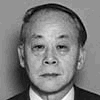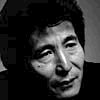 |
|
 |
 |

 |
 |
 |
Asian Films Get Its Turn in the New Century
by Kyushiro KUSAKABE(Film Critic / '99 Festival Advisor)
|
 |
The long awaited third Asian Film Festival has finally opened. I am eager to see how the new films have turned out. My heart is beating fast with anticipation. That is how I feel right now.
I was involved with the project of Asian Film Festival when it was first launched five years ago and I cannot say that I did not have both a great expectation and apprehensions for its outcome. But once the films were unveiled, I learnt I needn't have to worry; they far surpassed my expectation. NOSTALGIA FOR COUNTRYLAND from Vietnam and other films were all innovative and unique; most important of all, they were all 100% purebred Asian films.
The second Asian Film Festival had welcomed a new comer from Uzbekistan and was even more successful than the first one. And now, we are at the opening of the third Asian Film Festival with a line up of thirteen films and with projects from Japan as well. Asian countries have come to pin their high hopes on the NHK Asian Film Festival. As a matter of fact, the festival is attracting interest from the international film world as well.
I vaguely remember mentioning in my opening speech at the last festival, that "Asian film will have its turn in the new century." Two years later, I can safely say that it is already happening. Therefore, I would like to redefine the new century as "the century for Asian films to become the mainstream." I hope Asian films will come to form a union and the NHK Asian Film Festival shall be the matrix. It is already functioning as one and I can only hope that it will come to serve as a solid base for the union of Asian films by the beginning of the new millennium.
(Mr. Kenichiro Kusakabe passed away in August 2001. Requiescat in Pace.)
|
 |
 |
 |
Difference within Similarity
by Taichi YAMADA(Script Writer / '99 Festival Advisor)
|
 |
One of the appeals of Asian films is still the novelty of the unknown.
We can quite clearly picture in our mind a breakfast scene in America, but when it comes to the breakfast tables of Vietnam, Thailand, or even China, we have not much of a clue. Therefore, if we get to see them on the screen, it is a treat in itself. It may be that we are far more exposed to American films than that of our neighboring countries, to which we are much closer geometrically, that we should find ourselves so fascinated over such a minor detail. But I believe there is more to it than that.
Maybe we are more sensitive to finer distinctions within similarity than a clear contrast such as the difference between Russian or Swedish family life and ours. Difference within similarity offers us more to appreciate in finer details. For instance, the dinner table of one Japanese family and that of the family next door may seem similar to the eyes of foreigners. The two families, however, would notice some difference between their food and fuss over it.
We not only accept the difference within similarity but relish it too. Such is the appeal of Asian films, or so I believe.
Similarity also offers us the comfort of familiarity. We often react to Asian films nostalgically by saying, "My, we used to have that sort of sentiment in the old days in Japan, too." Of course we see things that remind us of contemporary Japanese, although frankly, that would not be too interesting. The charm of Asian films is that it allows us to reflect on things that we have lost by finding the similitude of Japanese of the old days on the screen. There are elements that are almost never found in American films: beauty of delicateness, acceptance of the fate, ambiguity, sentimentalism, selflessness, and the grace of endurance. All that has been lost to Japanese film for sometimes, we come to realize.
Asian films make us all see and feel where we've come to stand.
|
 |
 |
 |
For the Future of Asian Films
by Etsuko TAKANO(General Manager, Iwanami Hall / '99 Festival Advisor)
|
 |
It was in 1951 that late Akira Kurosawa won the Grand Prix for RASHOMON at Venezia International Film Festival. When another Japanese director, Teinosuke Kinugasa won the top prize, Palm D'Or for GATE OF HELL at Cannes International Film Festival in 1953, the international fame of Japanese films soared. For the years that followed the term Japanese films was synonymous with "Asian films".
Once in the Seventies, young directors from China, Hong Kong and Taiwan became active in the international arena, and by 1980s Asian films had taken over and become synonymous with Chinese movies. But if one observes it carefully, other Asian films have been maturing unnoticed by the world. Republic of Korea, Thailand, Vietnam, and Indonesia each has its own history of filmmaking. The Philippines is still the top maker of mass-entertainment films, while India boasts the highest number of yearly production of films in the world. The progress made in Iranian film industry is also remarkable.
In the world where American film has monopolized the commercial market, European countries, with France centrally located, are trying to combine their forces in the field of culture following the political and financial unification under the EU. Latin American countries are also uniting for the same purpose armed with the possession of one common language that is Spanish. Time has come for Japan to join hands with its Asian neighbors, and together we must put forth exertions for the enhancement of Asian films.
Hong Kong was handed over back to China in 1997. Last year, the ban on Japanese films in Republic of Korea was lifted by its government. These changing events that occur in the neighboring countries are bound to have influence on Japan. The number of joint film productions by Republic of Korea and Japan are on the increase. Mostly they are shot in Hong Kong and providing multi-national Asian actors and the crew with the venue and chances to work together. Fortunately, the rise and coming to the fore of a young generation is being observed in Japan as well.
"This Asian Film Festival" hallows us to view films from countries that we would not normally have a chance to know such as Mongolia, Uzbekistan, Malaysia, Sri Lanka, and many more. This festival is an invaluable asset in ensuring the future of Asian films because of its policy to provide the young filmmakers with production funds while respecting their freedom to determine content.
|
 |
 |
 |
How We Should Define Asian Films
by Tadao SATOH(Film Critic / '99 Festival Advisor)
|
 |
If the mainstream of American movies appears to hail the destructive heroes engaged in their hellish rampage, Asian films appear to endorse the everyday life of ordinary people striving to repair and preserve whatever daily necessities that they own. Commercial wise, the former basks in the absolute triumph. I believe, however, that it is the latter that needs to be nurtured and encouraged for the sake of the culture.
There are not many Asian films exported around the world, but no matter which international film festival one attends these days, masterworks with artistic flavor from China, Taiwan, Republic of Korea, Iran, and India are seen to have secured their places. Furthermore, the films from Mongolia, Vietnam, Indonesia, Thailand, and Sri Lanka are beginning to attract attention. The calling card of the films from these countries used to be simplicity, but now they have progressed into the advanced level of sophistication while still maintaining freshness.
Until quite recently, the world could be divided into two groups: a small number of countries in possession of all the technique and capability to produce films and the other parts of the world that are in want of them. Only ten years ago if I introduced any films from some small and minor countries, I would be asked which country had produced the film for them. I don't get this sort of questions very often these days, but the fact remains that there are still countries with a limited capability to produce films. Some has to have their films taken out to other countries where there are developing facility, and some simply needs a technical assistance of the developed countries.
I, myself, have seen films from over 120 countries and regions and nowadays it is hard to name a country that has not yet produced a film. But it is another story when it comes to distribution. Not all countries have the power to have their films distributed worldwide. In my opinion, the world can be assorted into a few groups from this point: the first group is consisted solely of USA. Their productions are distributed to every part of the globe save of a small number of countries that ban American films to be shown for some political reasons; the second group follows the footsteps of USA. It is consisted of developed countries of Europe and their Asian counterparts such as Japan, China, Taiwan, Hong Kong, India, Iran, and Republic of Korea. Whether they compare with on scale is much disputable; the third group has their own markets. Indian films enjoy popular supports in the market stretching from the Middle East to South Asia, while Egyptian film is popular among the Islamic nations. A small number of Latin American films are shown outside the country as well. The last group that comprises most of the world has a brief encounter with the moving image culture only in time of crisis such as civil wars, riots, famine and natural disasters when the media from the developed countries rush in to report the calamity to the world.
The producers of films, especially movies, usually focus and emphasis in the films the beauty and what they take pride in their country. With this in mind, we can divide up the world again in three parts: one is the group of countries with the ability to show off to the world their beautified image through films; another is the group of countries with a modest ability to do so; and lastly the countries who are exposed to the inquisitive eyes of the world only when they are in the state of disgrace and have no visual means to rectify its image.
I am very concerned that in the age of globalization when the world is coming closer to form a tight village-like bond, to have countries discriminated by their lack of self-expression may lead to a serious dissension.
One cannot fully appreciate the world by just visiting each country and observing it through the eye of the camera. One needs to know what is it that local people feel proud or ashamed about their own country through the films those people have produced themselves.
This never really worried us before as only a limited number of countries were producing films. However, now that is has become clear that majority of the world is making films, we ought to be avaricious about seeing more films from the countries heretofore unknown. We must ensure that developed countries help out those with potential but lacking in funds and techniques to produce films. Likewise with the countries where only entertainment movies are financed, so the creators of the country who wish to make artistic films are able to do so. The public broadcasters of England, France, Germany, and Australia have already played a vital role in providing such assistance. They had recognized the importance of promoting understanding among different countries and noticed that without it global understanding can never be achieved.
Needless to say NHK has been doing its vital share of contribution through the NHK Asian Film Festival.
|
 |
 |
 |
Asian Film, Its Original Strength to Defy
by Kohei OGIRI(Film Director / '99 Festival Advisor)
|
 |
Retrospective works by Robert Bresson were featured in the last Tokyo International Film Festival. His established style is uniquely his own and hardly the standard of Europe. Bresson is Bresson, through and through. And yet, the spirit we sense in his work is unmistakably European.
We used to have directors like that in Asia too. Ozu and Mizoguchi of Japan would fit in that category. Likewise in India, there is Satyajit Ray. These were the days when all the movies from the East were rounded up and labeled "Asian films".
Have things improved since then? We know of many great "Asian films". While Europeans never attempted to label their works as "European films", we had our reason to go out of our way to call our works "Asian films".
However, it is questionable whether we have managed to express the spirit of Asia in our works in the similar manner as Bresson has depicted Europe in his works.
Asia is very versatile in religion compared to Europe; while we may look similar on surface, each country is quite different from one another. And yet we are currently going through a big change over fusion of our differences within the world of media called film. Things are happening.
The issue is its content. The things that are taking shape may not immediately become commercially feasible. The film industry of most Asian countries is still fundamentally weak, and "Regional Asian films" are still under the great influence of the United States. Rushing its progress may cause for "Asian films" to lose its original strength to defy. Fusion cannot be achieved overnight.
I wish that NHK will continue to support Asian films so one day each of them will be able to stand on its own in its own right.
|
|





